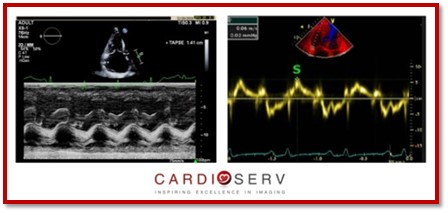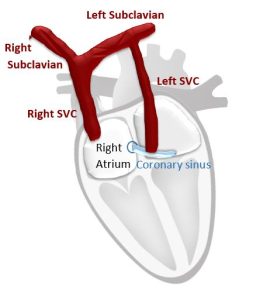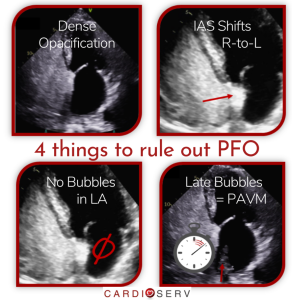We dedicated the month of April to learning about ways to implement right heart quantification into our routine exams. This month, we are going to continue that journey and discuss ways to evaluate the function of the right heart!
“RV systolic function should be assessed by at least one or combination of the following: FAC, S’ Wave, TAPSE or RIMP.” –ASE JASE 2015
With that in mind, let’s jump into how to perform these!
RV SYSTOLIC FUNCTION
The ASE explained 4 methods to quantify RV systolic function:
- TAPSE
- S’ Wave
- FAC
- RIMP
This week we are going to discuss how to perform TAPSE & S’ Wave measurements.
The reference values for these parameters do NOT provide a mild, moderate or severe value range. They do not take BSA, height or gender into consideration either. ASE provides us with normal and abnormal values.
IMAGING WINDOW
The ASE suggest using the standard AP4 window when performing RV function assessment.
Standard Apical 4 Chamber (AP4)
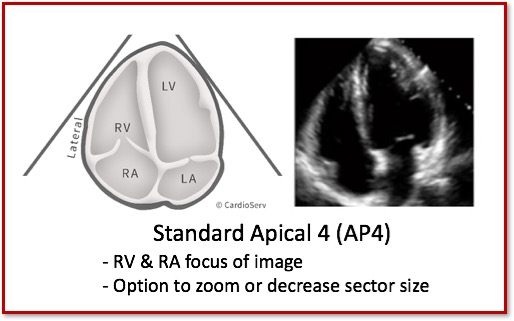
RIGHT VENTRICLE FUNCTION ASSESSMENT
TAPSE: Tricuspid Annular Plane Systolic Excursion
TAPSE is a linear M-Mode measurement of the RV longitudinal function.
- Wide Spread
- Established Prognostic Value
- Validated with Global RV Function
How to Perform TAPSE Measurement
- Align M-Mode cursor parallel to motion of lateral TV annulus**
- Annulus should be moving upwards towards the apex during systole
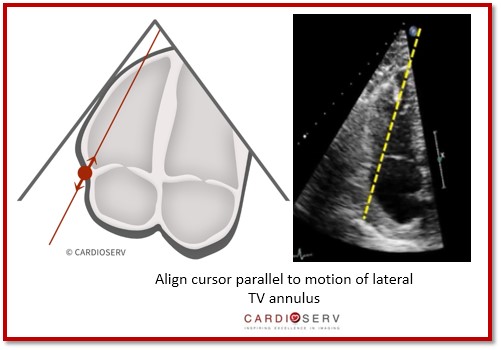
- Decrease gains to avoid measuring ‘noise artifact’
- M-Mode Speed: Medium-Fast
- Look for a consistent signal throughout systole and diastole
- Identify maximum systolic and diastolic excursion of annulus motion
- Measure VERTICALLY via leading-edge to leading-edge method
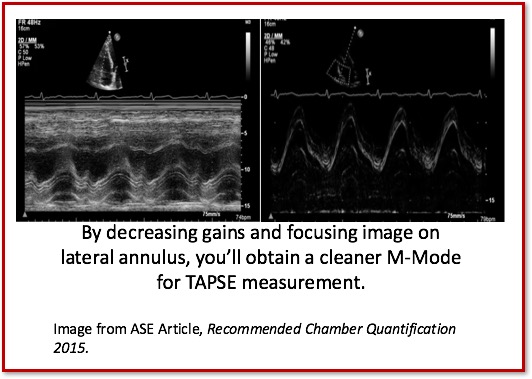
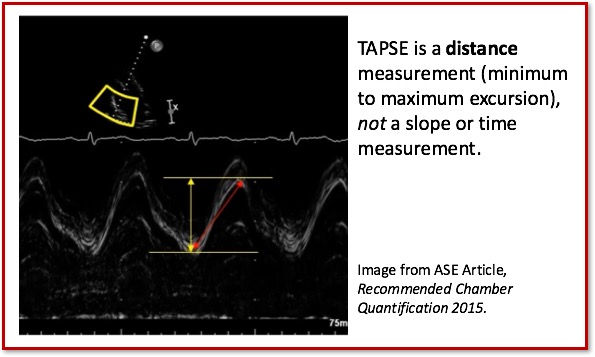
CHALLENGES/LIMITATIONS TO LINEAR MEASUREMENTS:
- Angle Dependency
- Easy to over and under-estimate RV function
Reference Values
There were changes to the cutoff value for TAPSE in the latest ASE guidelines and ASE acknowledged that although there may be minor variations in TAPSE values according to gender and BSA that generally a TAPSE value less than 17mm is highly suggestive of RV dysfunction.
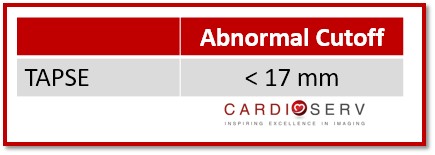
S’ Wave: TDI-Derived Tricuspid Lateral Annular Systolic Velocity
Peak systolic velocity of the tricuspid annulus by Pulsed Wave TDI (cm/sec).
- Good indicator of basal (lateral) free wall function
- Easy to perform & reproduce
- Established prognostic value
- Similar concept to TAPSE
How to perform S’ Wave Measurement
- Place cursor over lateral annulus of tricuspid valve
- Pulse Wave Doppler and TDI
- Decrease gains to avoid measuring ‘noise artifact’
- Identify maximum systolic velocity ABOVE the baseline—‘S’ Wave’
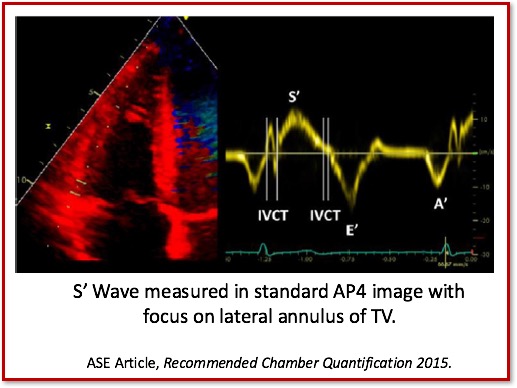
Challenges/Limitations to measurement:
- Angle Dependent
- Not fully representative of global RV function
- Easy to underestimate if Doppler signal is not parallel to annulus
Reference Values
Again, there were minor changes to the S’ reference range with the latest ASE guideline update. Just like TAPSE there are no values based upon mild, moderate or severe. The reference range provided is a cutoff range with a S’ value less than 9.5 cm/sec indicating RV dysfunction.
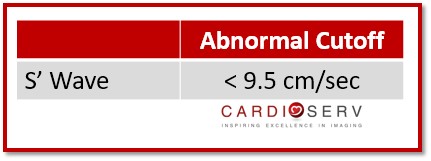
**HELPFUL TIP:
It is VITAL that we make sure we obtain both TAPSE and S’ Wave values to correlate together. If you are getting an abnormal TAPSE, then you need to make sure your S’ Wave is demonstrating an abnormal value as well.
Here is an easy reference chart to refer to in your scanning laboratory:
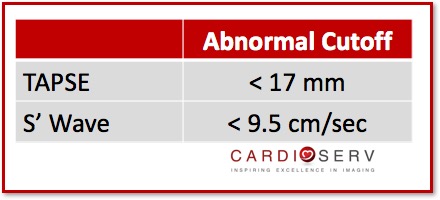
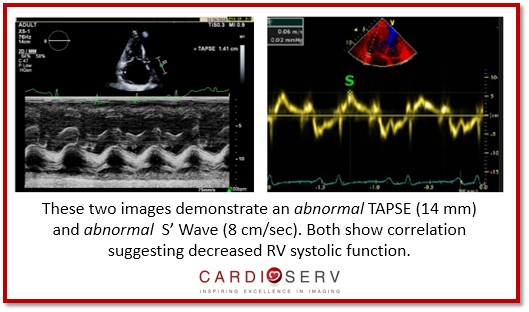
8 TIPS TO MEASURE TAPSE & S’ WAVE
- Use the standard AP4 view
- Utilize chamber focused imaging: we are only interested in the RV & RA!
- Make cursor parallel to motion of annulus!
- Use gain controls to optimize image
- Look for consistent sign for accurate measurement
- Adjust sweep speed to elongate waveforms
- Make sure TAPSE & S’ Wave correspond correctly to each other! Either both abnormal or both normal!
- Implement both measurements into your normal scanning routine!
CONCLUSION
The ASE provides us with four great methods to use for evaluating the RV function. If you’re not using any method to quantify right heart function, today is the day to start! We at CardioServ, suggest using both TAPSE and S’ Wave. If you are only limited to one, S’ Wave is easily obtained and more reproducible. If you do get an abnormal S’ Wave, it would be idea to also perform a TAPSE as an additional method to proving your abnormal value. Next week, we will discuss two other methods [RIMP & FAC] we can use for evaluating right sided function!
WANT A CME FOR READING THIS BLOG? CLICK BELOW TO ACCESS CARDIOSERV’S ONLINE CME PLATFORM OFFERING CAT. 1 AMA CMES!


Andrea Fields MHA, RDCS, Cardiac Clinical Director
References
Lang, R. M., MD, Badano, L. P., MD, & Mor-Avi, V., PhD. (2015). Recommendations for Cardiac Chamber Quantification by Echocardiography in Adults: An Update from the American Society of Echocardiography and the European Association of Cardiovascular Imaging. JASE, 28(1), 1-53. Retrieved March 1, 2017, from http://asecho.org/wordpress/wp-content/uploads/2015/01/ChamberQuantification2015.pdf

